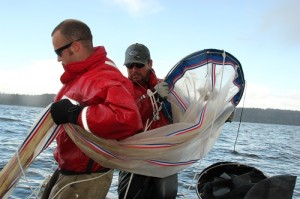May 27th, 2014 Northwest Indian Fisheries Commission
The Nisqually Indian Tribe is trying to find a way to predict future salmon runs by measuring what juvenile salmon eat on their way out to the ocean.
The tribe is expanding their research on local salmon to take a look at zooplankton in deep South Sound, which young salmon eat after leaving the Nisqually River. “Eventually, we might be able to connect the availability of food in Puget Sound with chinook runs three or four years down the line,” said David Troutt, natural resources director for the tribe.
As they migrate to the open ocean, juvenile salmon consume small animals like zooplankton. Nisqually tribal researchers want to find out if there’s less food in Puget Sound when salmon are migrating out, meaning fewer may be coming back.

The study will examine the entire community structure of competitors and predators, including plankton and other fish species. A smolt trap operated by the state Department of Fish and Wildlife on the Nisqually River will determine the timing, size and number of out-migrating salmon.
The tribe will sample juvenile fish from the Nisqually estuary and adjacent marine areas using a beach seine and lampara net. At the same time, the tribe will sample the water for zooplankton and other small animals. “If we find that in years when a lot of food is available, salmon survive to return at higher rates, we could more easily predict future salmon runs,” Troutt said.
In an earlier study of chinook leaving the Nisqually River, the tribe found a direct connection between fish that were able to find food in the river’s estuary and those able to make it back as adults. “We typically find two groups of juvenile chinook leaving the watershed,” Troutt said. “The fish that stayed and fed in the estuary survived to return as adults while those with other life history strategies did not.”
The tribe’s research is part of the region-wide Salish Sea Marine Survival Project. The project brings together researchers in both the United States and Canada to better understand the relationship between salmon and the marine environment.
Treaty Indian tribes are locally based and use cutting edge management techniques, making them uniquely qualified to conduct close to the ground research. “Being able to understand the salmon life cycle is important if we want to preserve our treaty protected right to harvest salmon,” said Georgiana Kautz, natural resources manager for the tribe. “Our treaty rights depend on there being fish actually available to harvest.”
